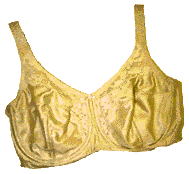Claim: The brassiere was invented by Otto Titzling.
Origins: The realm of popular wisdom is replete with well-traveled factoids that found their way into our culture via a deliberate hoax or playful leg-pull. Such is the case with the notion that the brassiere was invented by the so appropriately named Otto Titzling.
According to an inventive history of the undergarment that is now widely believed, Titzling came to invent the item while living in a New York boardinghouse in 1912. One of his neighbors was a buxom opera singer named Swanhilda Olafson, and the structural engineering problems she presented inspired Titzling

to create a contraption to uphold this lady's ample bosom. In the early 1930s, a French fellow named Phillip de Brassiere began producing a similar undergarment. Titzling sued, but Brassiere won in court, and that is why today we call a lady's frontal uplifter a brassiere instead of a titzling.
It's a great story, but there's no truth to it. The madness began with a 1971 book by Wallace Reyburn titled Bust-Up: The Uplifting Tale of Otto Titzling and the Development of the Bra. Like his 1972 send-up, The Inferior Sex: A Treatise on the Inferiority of Women, Bust-Up was a work of satire. (Reyburn wasn't always a jokester, however. Although his biography of
The brassiere has been around in one form or another at least since Greek women wore a chest binding called a mastodeton or apodesmos while exercising. When to date the invention of the modern brassiere to presents a bit of a problem — it depends upon how one defines the
contraption.
Metallic constructions that looked like bras and did serve to hold matters rigidly in place were around as early as 1859, as a patent granted to
Closer to the concept was
Olivia P. Flynt's 1876 "bust supporter" could possibly be pointed to as the original brassiere provided one accepts shoulder straps that look more like the shoulder yokes of an ordinary blouse. Flynt designed a fabric garment that fit around the upper half of the torso, holding each breast in a fabric pocket supported by shoulder straps. Though the illustration used to support her patent application showed an unadorned garment, written notes accompanying the sketch indicated that the straps could both be made thinner and adorned with lace. She also provided for a double-walled version which permitted the insertion of additional padding to enhance an underdeveloped lady's charms.
Charles Moorehouse came up with an inflatable breast enlarging garment in 1885. It featured air-filled rubber cups that held each breast, and the strapping design is not so far removed from today's undergarments to render his creation unrecognizable as a proto-bra.
Most experts, however, point to 19th-century French feminist Herminie Cadolle as the true inventor of the brassiere and the date of the invention as 1889.
Upon moving to Argentina in the mid-1800s, Cadolle opened a shop selling fancy French underwear. The enterprise flourished, turning Cadolle into a globetrotting businesswoman. Her active lifestyle and busy schedule soon convinced her there just had to be a better foundation garment for women like her than the then-universal and very uncomfortable corset.
In 1889 she moved back to Paris, there to set up her main shop. She soon after began work on the task of engineering a better undergarment. The top half of her 1889 two-part invention was "designed to sustain the bosom and supported by the shoulders." (The bottom half was a corset that covered only the waist and rear.) Cadolle named this two-piecer le bien-être (the wellbeing).
By 1905, the two-piecer had become two separate pieces, with the top half coming to be called a soutien-gorge (throat support).
How and when the modern bra gained the name we now know it by remains unclear. "Brassiere" is an ambiguous word to attempt to trace because it was around a long time before anyone thought to use it as the name for a woman's breast-holding undergarment. It had been employed since
According to the Oxford English Dictionary, the word means "a woman's undergarment worn to support the breasts."
Who connected that word with that meaning, however, is unknown and possibly unknowable. Some say an American named Charles de Bevoise christened it thus in 1902. Others assert that the word turned up in an 1890 issue of Vogue magazine, and others dispute them, saying it didn't appear there until 1907.
Barbara "bra brawl" Mikkelson
Sightings: Bette Midler sings about Otto Titzling and his wonderful invention in the 1988 movie Beaches and on her 1986 album, "Mud Will Be Flung Tonight." Also, a Trivial Pursuit game card incorrectly gives the inventor of the bra as Otto Titzling.
Last updated: 19 May 2011
Sources: |
Ching, Tee Hun. "Mammary Lane." The [Singapore] Straits Times. 31 December 1999 (Millennium Special; p. 12). Corrigan, Patricia. "A Century Undercover: Looking at the Bra As a Barometer of Society." St. Louis Post-Dispatch. 9 July 1989 (p. C1). Levins, Hoag. American Sex Machines. Holbrook, Mass: Adams Media, 1996. ISBN 1-55850-534-2 (pp. 147-163). Panati, Charles. Sexy Origins and Intimate Things. New York: Penguin Books, 1998. ISBN 0-14-027144-9 (pp. 223-224, 233-234). Reyburn, Wallace. Bust-Up: The Uplifting Tale of Otto Titzling and the Development of the Bra. New York: Prentice-Hall, 1971. ISBN 0-13-108761-4. Library of Curious and Unusual Facts: Inventive Genius. Virginia: Time-Life Books, 1991. ISBN 0-8094-7699-1 (p. 34).
